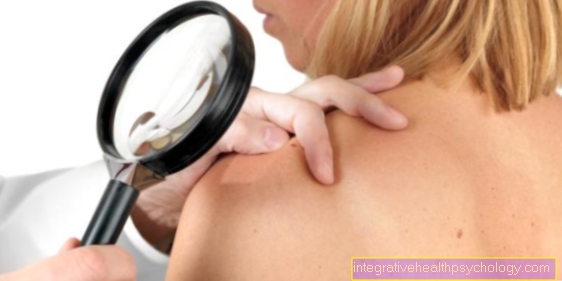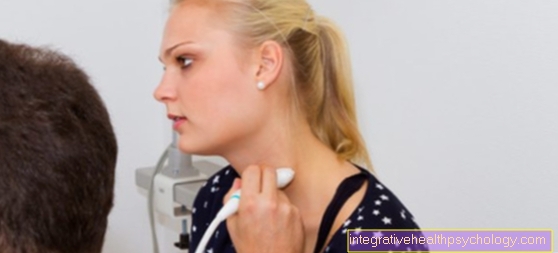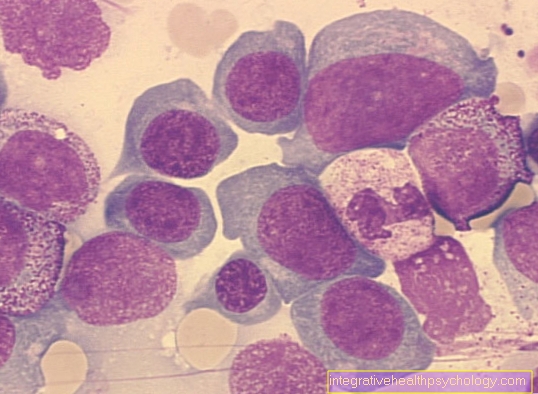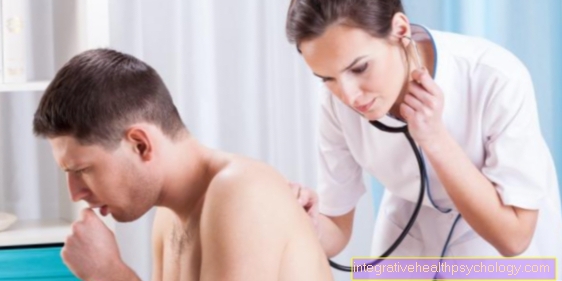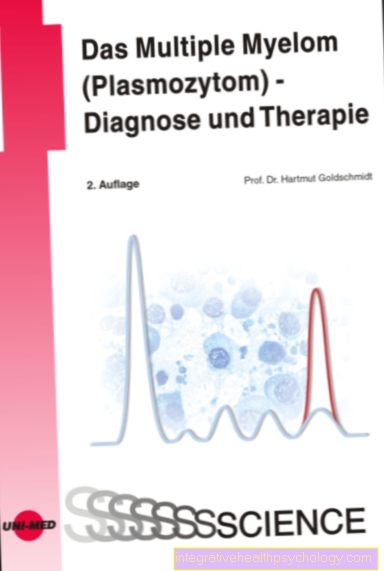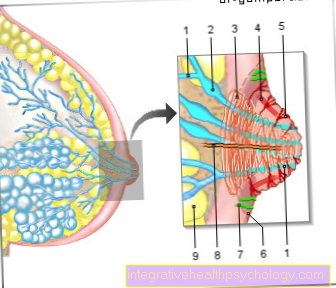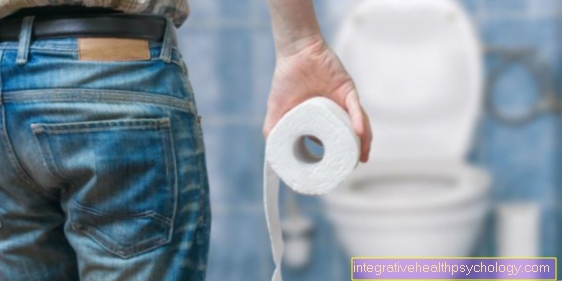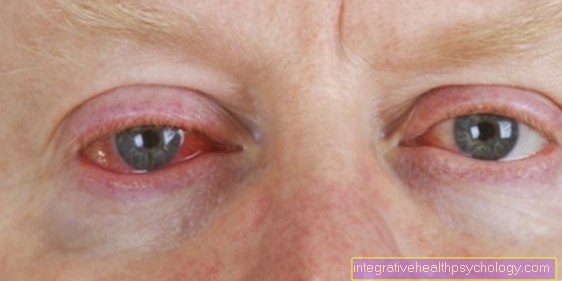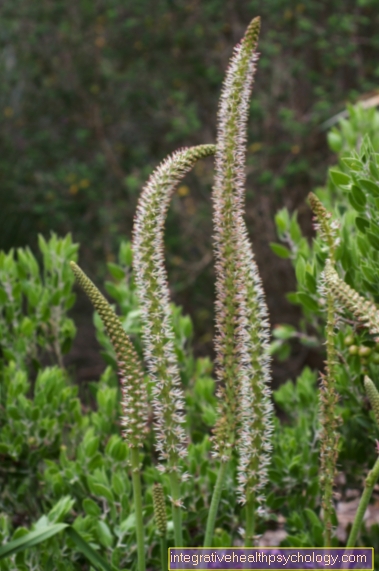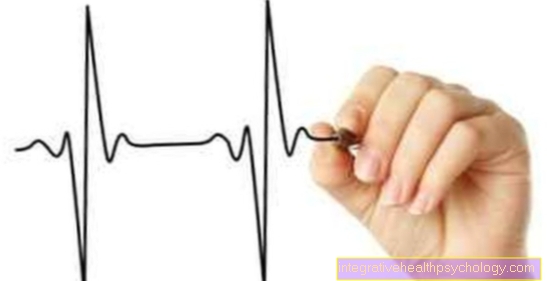carbuncle
definition
An inflammation of several neighboring hair follicles is called a carbuncle, also known as a boil. A carbuncle can develop from inflammation of a single hair follicle, known as a boil, which then spreads to other hairs and as a result they also become inflamed.
Carbuncle can appear anywhere on the body where there is hair. However, they mostly occur on the face or buttocks and can be extremely painful.
If the inflamed area heals, it usually heals with scarring. It is urgently advisable not to express the carbuncle yourself or otherwise manipulate it yourself, as this usually only makes the inflammation worse and the scarring is usually much worse.

Symptoms of a carbuncle
The symptoms of carbuncle are the usual signs of infection. This includes:
- overheat
- Pain
- Redness
- swelling
In addition, mine can feel a rough lump, which is usually quickly visible as a yellow plug of pus. There is warm, reddened skin around the pus nodule. The surrounding area and the lump are usually painful. Fever and a general feeling of illness with fatigue and tiredness may also occur. Swollen lymph nodes can also appear in the area, they can also cause pain, but are usually only tender on pressure and usually do not cause any problems.
The pus plug usually empties by itself when it bursts open. However, it can take a few days for the pus to burst on its own. However, you should never try to manipulate the carbuncle yourself, even if the carbuncle has already burst.
Therapy of a carbuncle
Depending on the size and location of the carbuncle, there is a conservative or surgical option. However, carbuncle usually has to be surgically removed or cut open to remove the pus and treated with antibiotics.
In most cases, surgery is the only way to heal a carbuncle, as pull ointments or other creams often do not heal. These usually only help when it comes to individual hair follicles, i.e. boils.
Carbuncles surgery is usually not performed under anesthesia, but rather under what is known as local anesthesia (local anesthesia). However, depending on the size, local anesthesia may not be sufficient and the operation still has to be performed under general anesthesia. First, the area around the carbuncle is disinfected and demarcated from the rest of the skin with sterile cloths. After disinfection, the local anesthetic is injected. Here, the area to be operated on is injected fan-shaped with a local anesthetic. At this point, the sensation is clearly limited and a feeling of pain is completely eliminated, so that you should not feel any pain when cutting out, but only notice pushing and pulling. The effect can be checked by touching the skin with a pointed object and asking the patient if he can still feel anything.
After checking the effect, a spindle is drawn around the carbuncle to mark the cutting lines. A spindle shape to bring the wound edges closer together again afterwards and thus to leave a nicer and less visible scar, which is of particular importance in the area of the face. The spindle position is selected on the basis of so-called skin gap lines in order to have as little tension as possible on the seam afterwards. A higher tension can lead to a reopening of the wound and ultimately to a larger and more visible scar.
The next step is to remove the entire carbuncle. Depending on the size, you can open the carbuncle and let the pus drain away, or you can remove the carbuncle as a whole. If you open the pus cavity and let the pus drain off, the cavity is then rinsed and cleaned several times. As the last step, the wound is sutured again.
It may be useful to administer an antibiotic after the operation to prevent the inflammatory germs from spreading. The threads used should ideally be removed after about 7-8 days.
Home remedies to treat carbuncles
Basically, carbuncles are serious infections of hairy skin that require medical treatment. A warm black tea bag can be used to alleviate the symptoms. This has an antibacterial and calming effect. There are home remedies to empty the pus. In order for the pus to empty, the carbuncle must mature. To promote maturation, you can try moist heat; a visit to the sauna, warm milk or a warm, damp washcloth can cause the carbuncle to empty.
Chamomile tea or thyme tea can also be used as they have antibacterial properties. For this you put a washcloth or a towel in hot chamomile or thyme tea and place it on the carbuncle. Hot salt water, which also has a disinfecting effect, is also popular. We strongly advise against bursting a carbuncle yourself. The infection is caused by stubborn bacteria and should be monitored and treated by a doctor. In order to prevent the purulent inflammation from simply migrating and returning, a small surgical procedure with subsequent antibiotic therapy is usually necessary.
Formation and dangers of a carbuncle
In principle, a carbuncle can appear anywhere where there is hair on the body. However, carbuncles often occur in the face area or on the buttocks. Since a lot of small hairs grow on the face in particular, boils (inflammation of an individual hair follicle) and carbuncles can also develop here.
The cause of the inflammation is often an infection with bacteria. An infection with the pathogen Staphylococcus aureus is particularly common. This is a germ that, like some other bacteria, is normally always on the skin, i.e. it belongs to the normal skin flora and only leads to inflammation under certain circumstances.
A carbuncle of the nose can occur due to a weakened immune system, poor hygiene or a changed hormone level, such as occurs during puberty, for example.
In contrast to carbuncle on the back or in the neck, carbuncle in the nose is particularly dangerous because the distance to the brain is very small. The bacteria can spread quickly via the blood and lymph vessels and reach the brain, where they can then also lead to infection and inflammation. The meninges, which surround the brain like a coat, can be particularly affected. An inflammation of the meninges is also known medically as meningitis. It is therefore particularly important to leave the carbuncle of the nose, but also the carbuncle of the lips, alone and not empty the pus that develops on your own. Even if carbuncles of the nose are particularly noticeable and can also be very painful, as there are many sensitive nerve fibers in this area, you should still not express them, but rather go to a doctor early.
In contrast to boils, only surgical removal helps with carbuncles, as pull ointments or other creams are often no longer sufficient. Therefore, it makes sense to see a dermatologist early to prevent further spread of the inflammation to neighboring hair follicles so that the inflamed area does not become too large.
Read more on the topic: Causes of a boil
Causes of a carbuncle
The carbuncle is caused by bacteria, which in medicine are called staphylococci. These are bacteria that can be found on every skin and usually do no harm. However, if these bacteria penetrate deeper skin layers, they can cause inflammation there. If several hair follicles ignite or melt together, a carbuncle is created. These bacteria are fought by the body's own immune system and pus accumulates. Why some people are more prone to boils and carbuncles is not exactly understood. However, there are some risk factors that can cause the inflammation to develop. This includes:
- Smoking: Patients who smoke are 10 times more likely to develop carbuncle
- Patients with an inherited immune disorder are also at increased risk of developing carbuncles
- diabetes mellitus is a risk factor
- Skin diseases such as impetigo or sycosis also promote the development
- Drugs such as cortisone can affect the immune system and also promote inflammation
- lack of disinfection, especially after shaving. By damaging the skin during shaving, bacteria can penetrate more easily and thus lead to boils or carbuncles.
Where can carbuncles arise?
In addition to the face, there are other locations where carbuncles can occur.
Carbuncle on the bottom
When hair follicles become inflamed, boils develop. If several boils ignite, they together form a purulent carbuncle. Carbuncles can appear anywhere that hairy skin is found. In addition to the face, carbuncles are often found on the buttocks. As a rule, bacteria are responsible, often the bacterium Staphylococcus aureus. A carbuncle on the buttocks is a boil that is characterized by overheating, redness, swelling, and pain.
A pronounced carbuncle can also cause general symptoms such as fatigue, tiredness and fever. Depending on the position of the carbuncle on the buttocks, sitting can sometimes be very uncomfortable, as carbuncles are very painful on pressure. There are several ways to treat a carbuncle on the buttocks. Occasionally, carbuncles are treated conservatively, using creams and ointments. However, surgery is often necessary to remove the carbuncle under local anesthesia. In addition, antibiotic therapy is usually used to eliminate the bacteria that are responsible for the boil.
Carbuncle in the genital area
A carbuncle in the genital area is a painful boil under the skin. By inflaming multiple hair follicles into boils, a carbuncle can develop. A boil in the genital area can lead to swelling of the lymph nodes in the groin area and a feeling of weakness, fatigue and fever. The boil itself is red, warm, swollen and extremely painful on pressure. A carbuncle in the genital area requires medical treatment. Depending on the size of the carbuncle, conservative therapy with pulling ointment can be tried, or surgical cleavage of the carbuncle can be tried directly. Antibiotic therapy is then indicated so that the germs are successfully eliminated.
Read more on the topic: Pull ointment / Ichtholan®
Carbuncle in the armpit
Painful carbuncles form in hairy skin and therefore often in the armpit. When several small inflamed boils come together, a large boil can develop in the armpit. A carbuncle in the armpit is characterized by the typical symptoms of inflammation, redness, warming, swelling and pain. The purulent bump needs medical treatment and should not be expressed on its own.
diagnosis
The diagnosis of carbuncle is a visual diagnosis. Carbuncles stand out due to their typical appearance with a reddish border of one or more pus nodules, which are rough to the touch. The typical places where carbuncles appear are:
Facial area
Armpits
Nasal area
Po
Chest area
To clarify the pathogen, a smear be taken. However, it is mostly the bacterium Staphylococcus aureus.
If the carbuncles keep coming back, one speaks of a recurring occurrence and it may be necessary to look for immunodeficiencies or diseases that cause this immune system weaknesses.
prophylaxis
Patients who get carbuncles more often should observe very strict personal hygiene. However, good personal hygiene does not always offer 100% protection. If the carbuncle is caused by an immunodeficiency, the immunodeficiency must also be treated, otherwise carbuncle will arise again and again. The so-called muciprocin ointment can also be taken to avoid repeated infections.
forecast
If not immunosuppressed or immunocompromised Patients have a good prognosis that the carbuncle will heal and not come back.
However, they often stay pitted changes back. Patients who are prone to what is known as colloidal scarring may also leave larger scars.
If a carbuncle is left untreated, it can have dire consequences. If the pathogen spreads in the blood it can lead to a sepsis, so one Blood poisoning come. In the worst case, this can even be fatal. The pathogens spread in the blood and enter brain one, they can cause irreparable damage. Hence in each case a Doctor visit to recommend.


